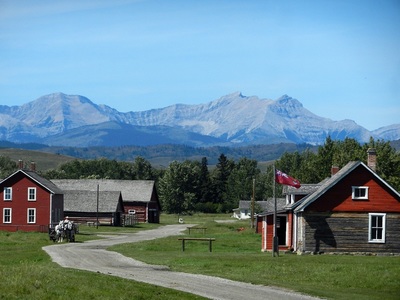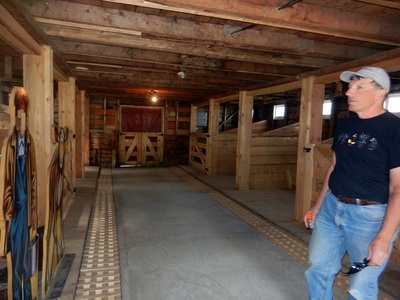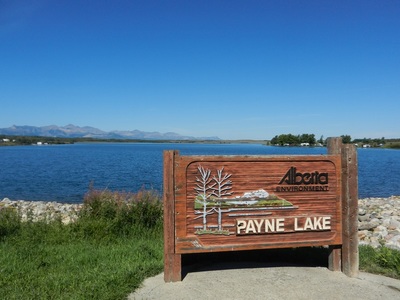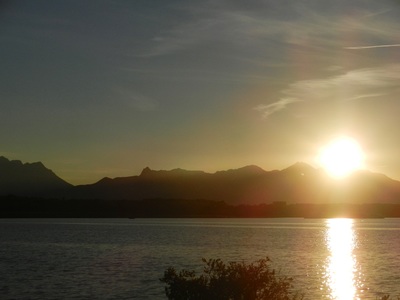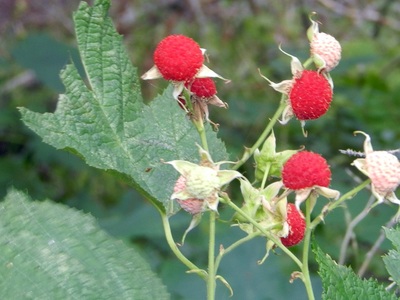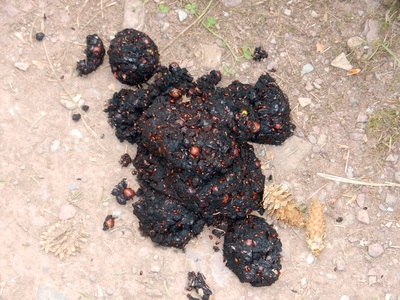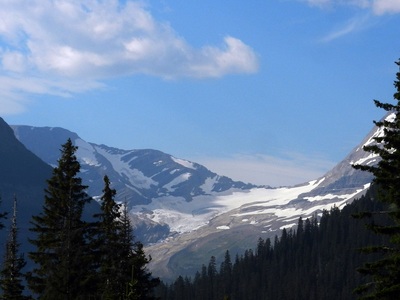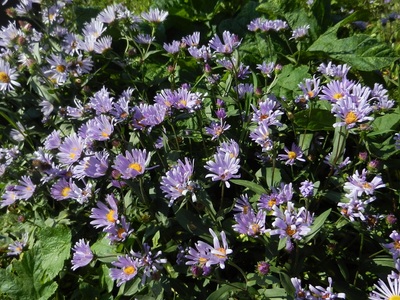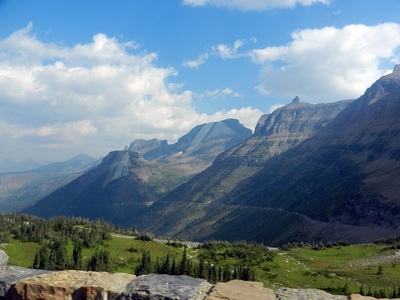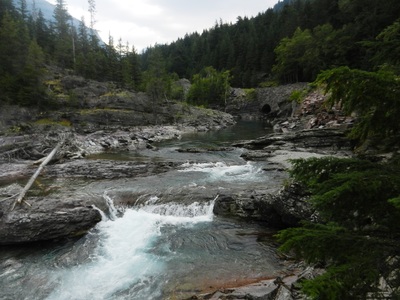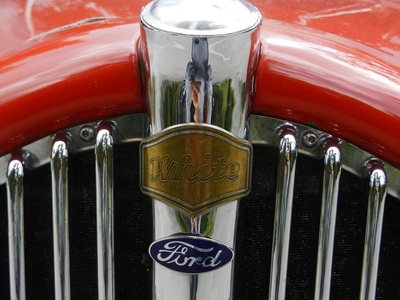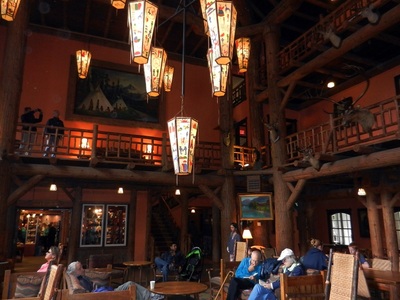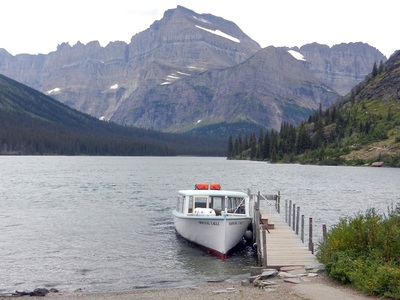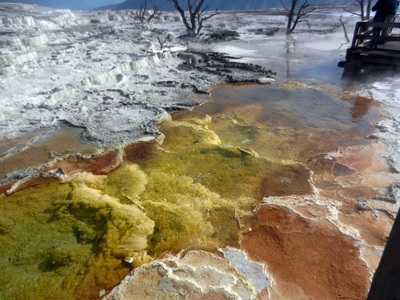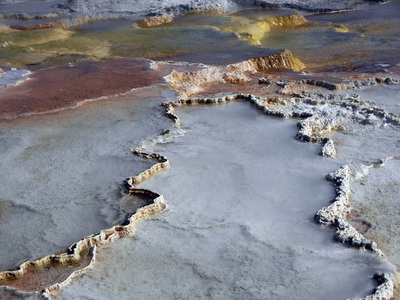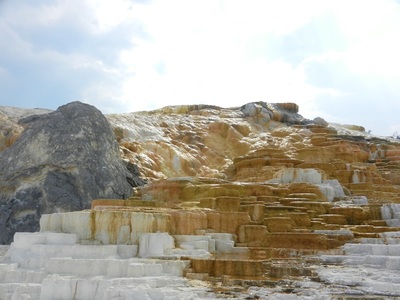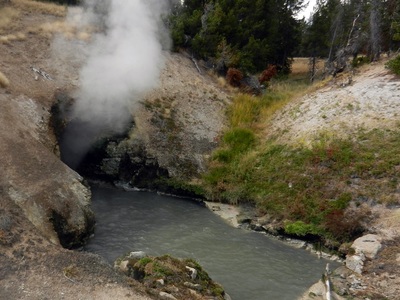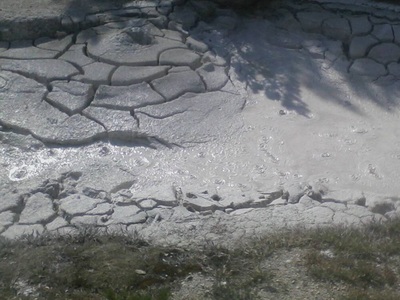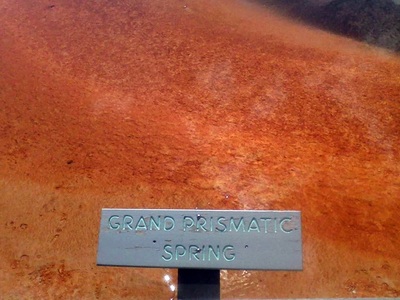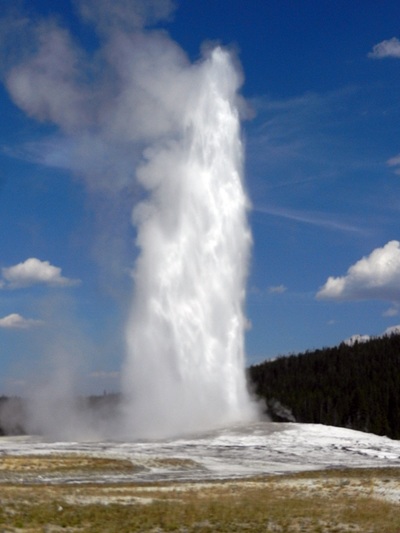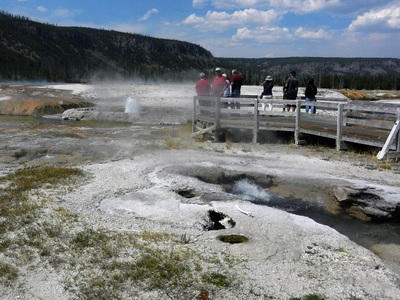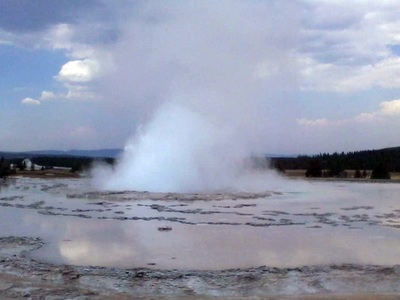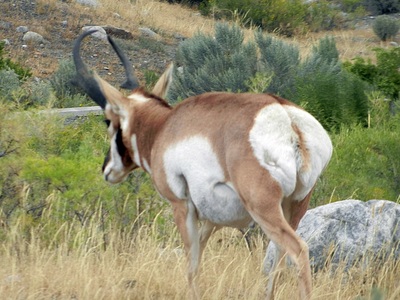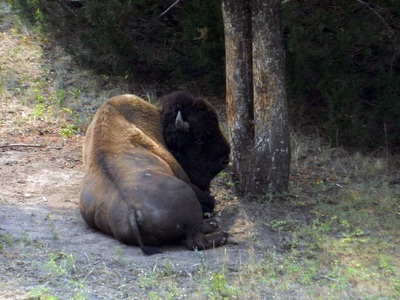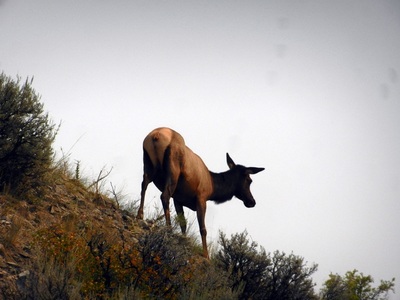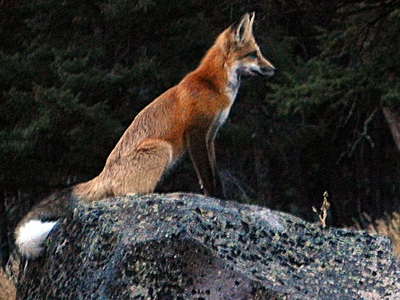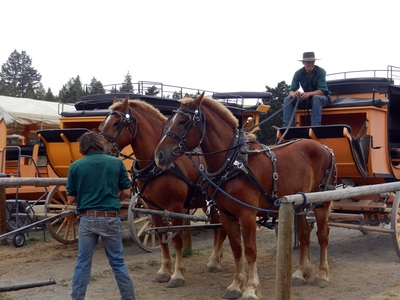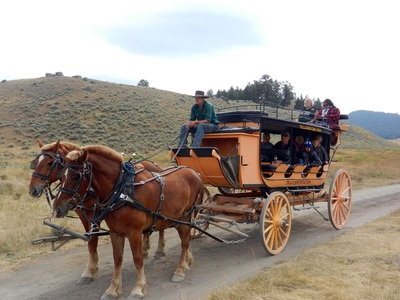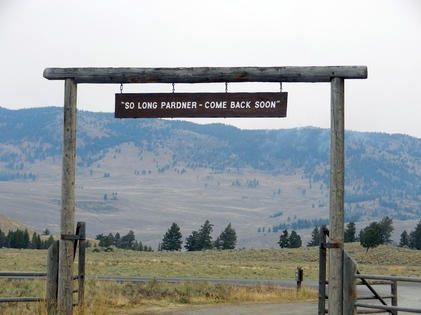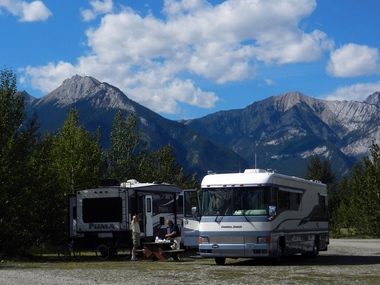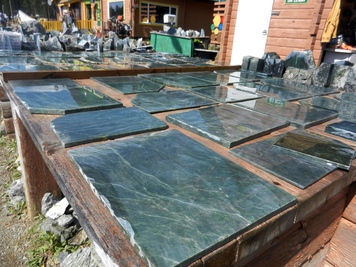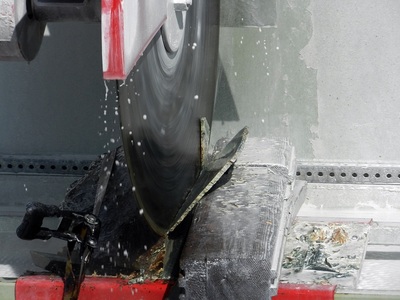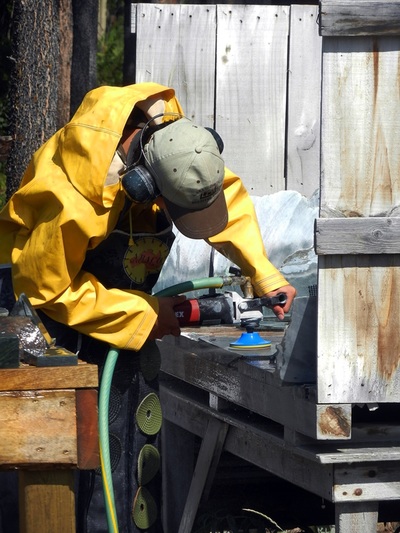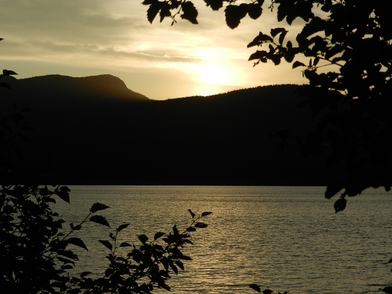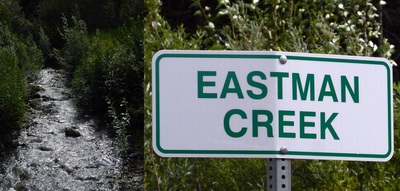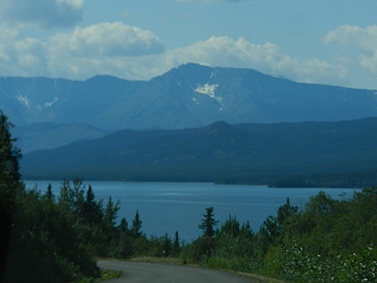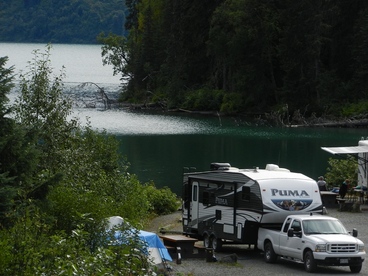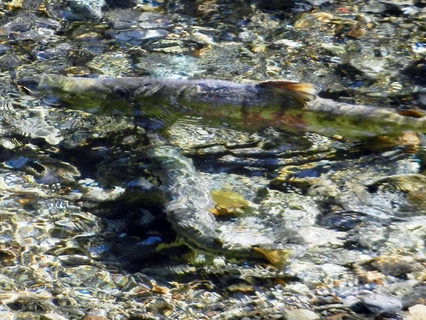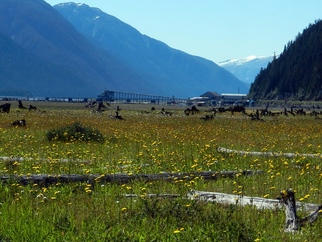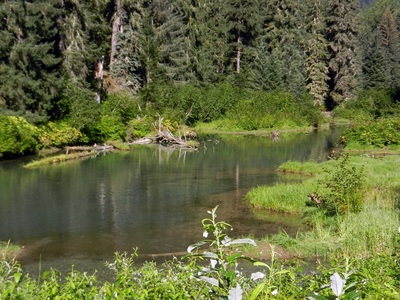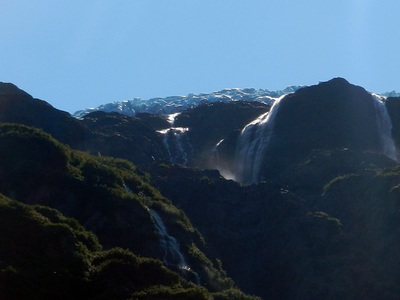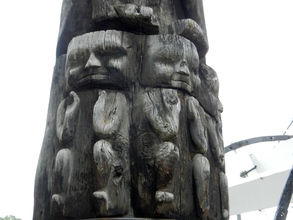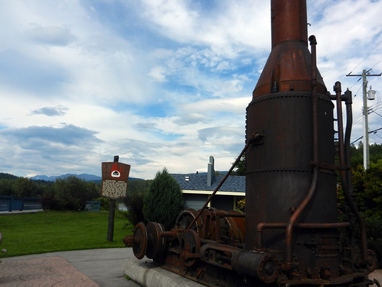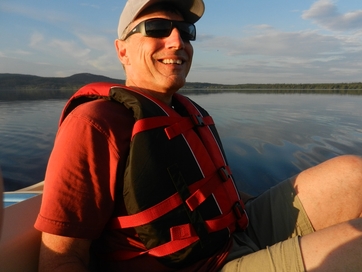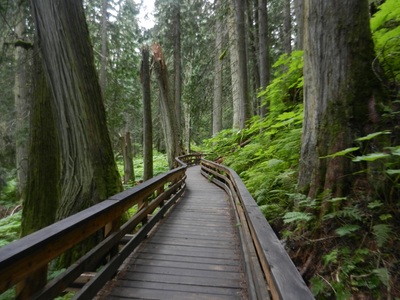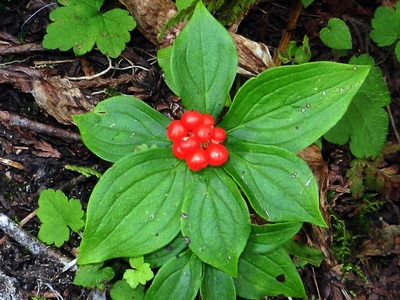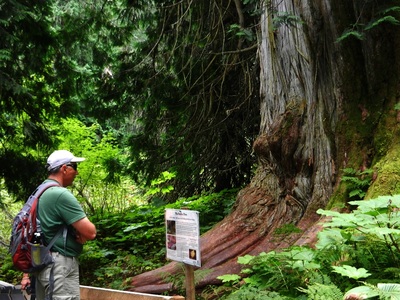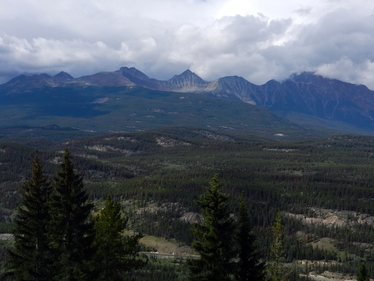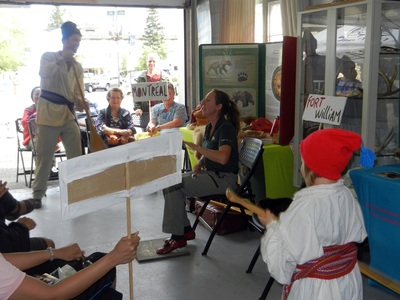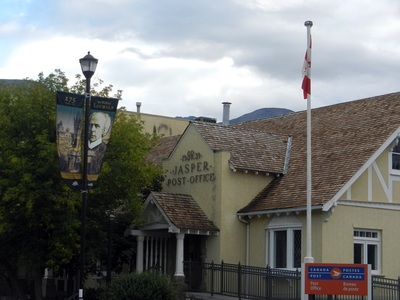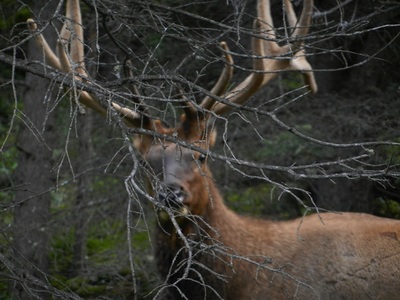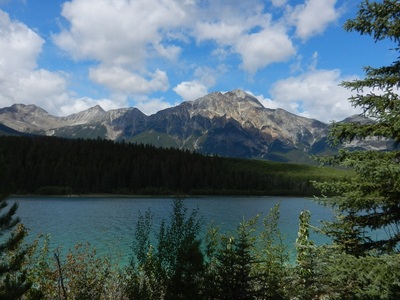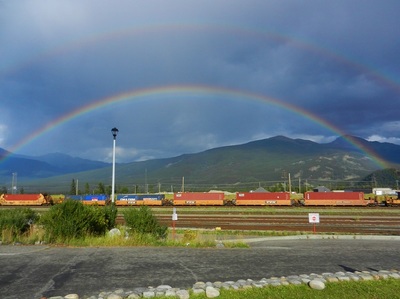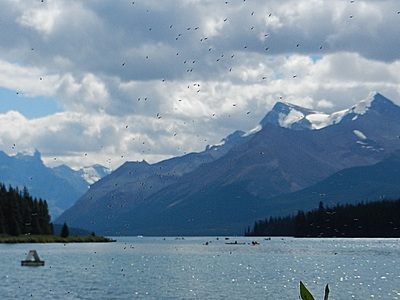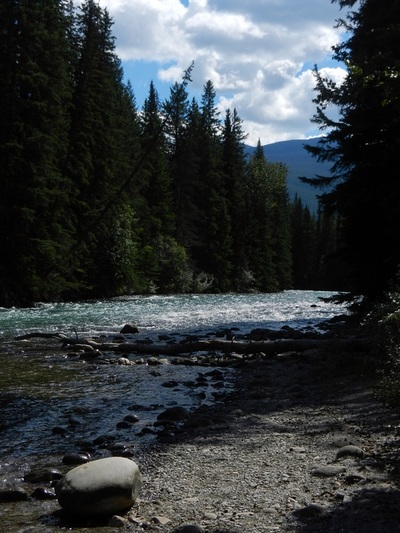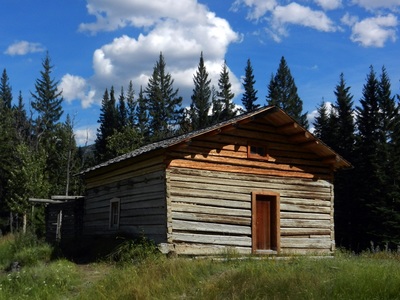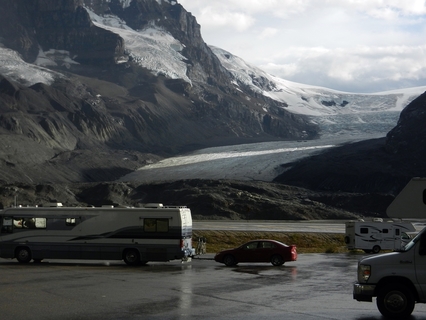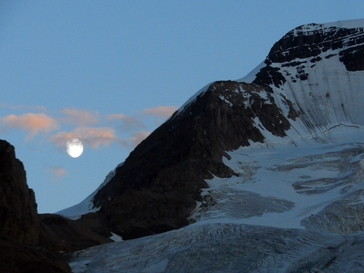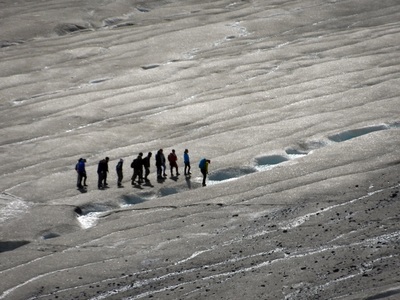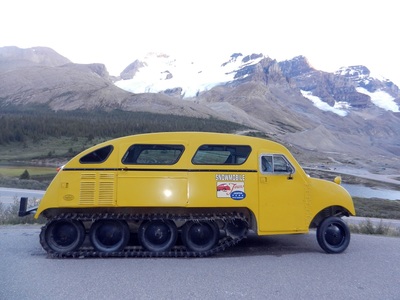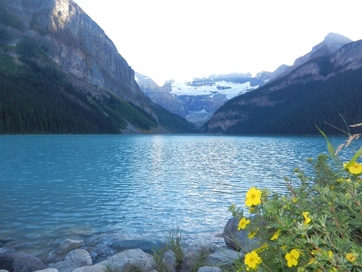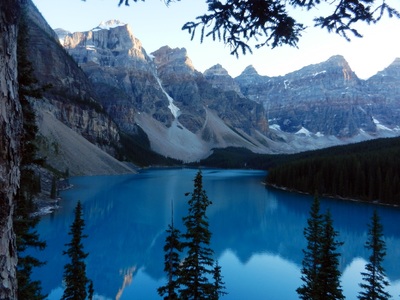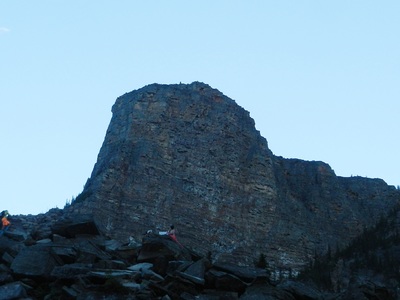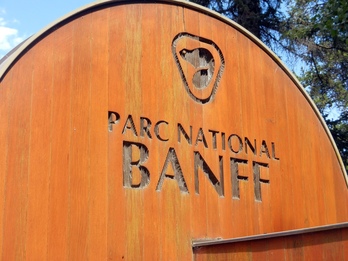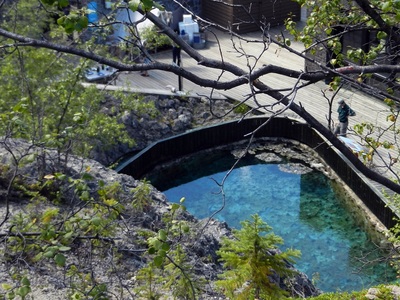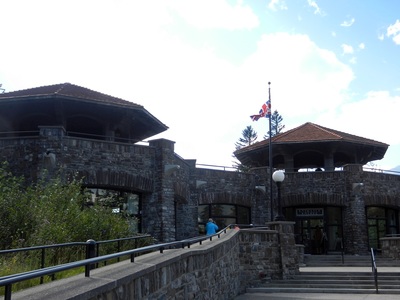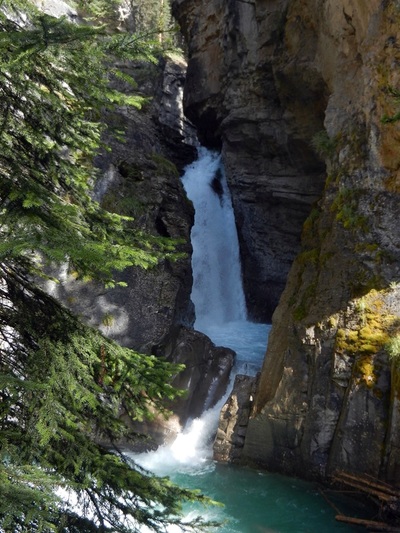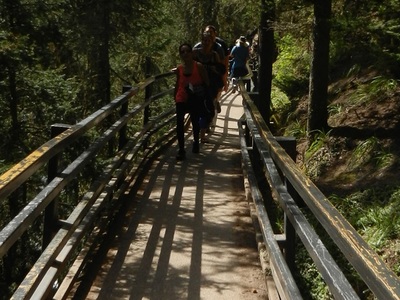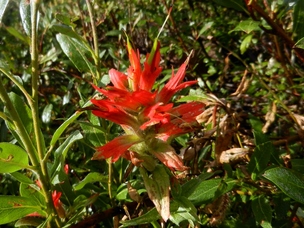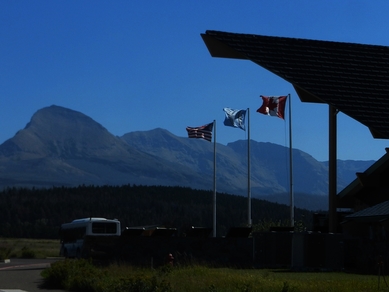 Glacier National Park on the US-Canadian Border
Glacier National Park on the US-Canadian Border After leaving Banff National Park in Alberta, we made our way south toward the US border, where we were re-joined by Pat and Fred just in time to cross into Montana. As the national park service was in the middle of celebrating its 100th anniversary, we helped them out by visiting two of its more popular parks – Glacier and Yellowstone.
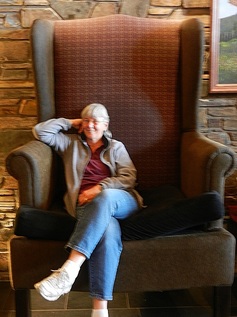 Cathy at Stoney-Nakoda Casino
Cathy at Stoney-Nakoda Casino Leaving Canada
One of the places that often welcomes RV’ers for free overnights is a casino. We found one after leaving Banff on the lands of the Stoney-Nakoda First Nation people, west of Calgary. We had a great stay, enjoyed a good meal and even did some laundry. We did gamble a small amount, but it was fortunate that we kept the amount small.
One of the places that often welcomes RV’ers for free overnights is a casino. We found one after leaving Banff on the lands of the Stoney-Nakoda First Nation people, west of Calgary. We had a great stay, enjoyed a good meal and even did some laundry. We did gamble a small amount, but it was fortunate that we kept the amount small.
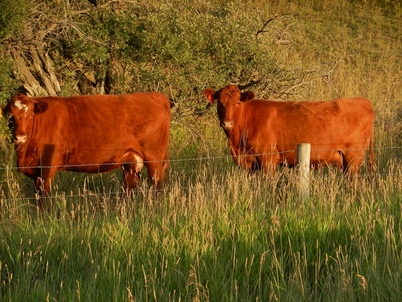
We took scenic route 22 south toward the border through ranch country, following a line just east of the intersection of the prairies and the Canadian Rockies. This geography creates some amazing winds, including the famous Chinooks in the winter (strong southerly winds). The high wind caution signs along the highway gave us the sense of how minor the 20mph winds we experienced were.
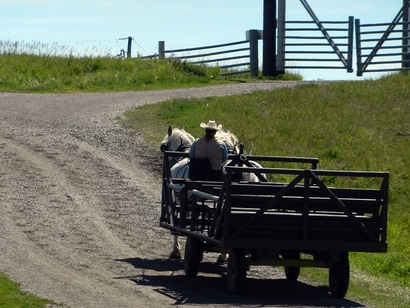 Percheron horses pulling wagon at Bar U Ranch
Percheron horses pulling wagon at Bar U Ranch To learn more about the area, we stopped in at the Bar U Ranch National Historic Site. A small remnant of the first and most successful of the cattle ranches in western Alberta. The historic site recreates life on the ranch in the late 19th and early 20th century.
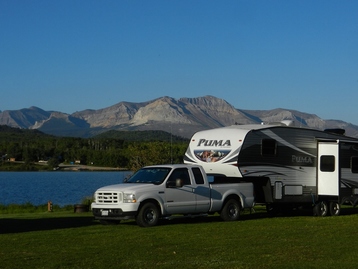 Payne Lake Provincial Park
Payne Lake Provincial Park Our plans to spend the night at Waterton Lakes National Park (the partner park to Glacier National Park in the US) were scuttled when we arrived to learn that all their campgrounds were full, as were the nearest private campgrounds. Luckily, we were directed to Payne Lake Provincial Park, where we found a beautiful and spacious lakeside campsite. Our only problem with this last-minute change in plans was money. With our imminent return to the US, we had spent down most of our Canadian currency. Unfortunately, Provincial Parks accept only cash. For our first night, we scraped together the last bit of our Canadian cash to come up $1 short of the night’s fee. The camp host graciously accepted it, but told us that we would have to pay in Canadian currency if we stayed another night. Our friendly neighbors graciously swapped some of their Canadian money for our US dollars so we could pay for our second night. With our site secured, we hiked up the hill behind the lake and enjoyed the beautiful scenery and pleasant company, amazed at how lucky we were to find this spot.
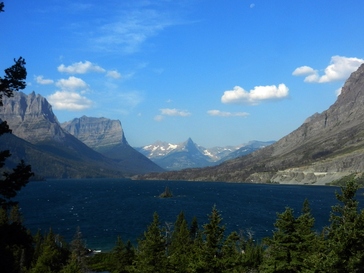 St Mary's Lake at Glacier National Park
St Mary's Lake at Glacier National Park Glacier National Park
The knock on the door took us by surprise. Figuring it to be one of our neighbors at Payne Lake, we were surprised to see Pat and Fred. It was Sunday morning and the last communication we had had with them was Friday night over a borrowed cell phone, quickly describing our change of plans. We hadn’t had any way to call or receive an e-mail from them since. We learned that they had spent a night in Lethbridge getting a hose replaced on their engine and another night at Head-Smashed-In Buffalo Jump (an interesting stop that we missed) before taking a chance on finding us still at the Provincial Park.
The knock on the door took us by surprise. Figuring it to be one of our neighbors at Payne Lake, we were surprised to see Pat and Fred. It was Sunday morning and the last communication we had had with them was Friday night over a borrowed cell phone, quickly describing our change of plans. We hadn’t had any way to call or receive an e-mail from them since. We learned that they had spent a night in Lethbridge getting a hose replaced on their engine and another night at Head-Smashed-In Buffalo Jump (an interesting stop that we missed) before taking a chance on finding us still at the Provincial Park.
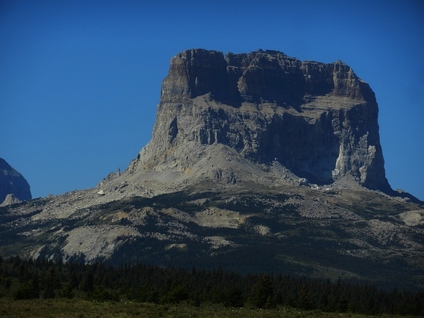 Chief Mountain in Glacier National Park
Chief Mountain in Glacier National Park Only a few miles from the US border, we left together and arrived at our campground in northern Montana early afternoon after a short drive. We crossed the border on the scenic road within Waterton Lakes National Park. With Glacier National Park’s campgrounds full, we decided to stay at Chewing Blackbones RV Park, which was on the Blackfoot Reservation a few miles north of Glacier National Park’s east entrance at St. Mary’s. Over the next few days, we explored the park.
 Classic shuttles climbing the Going to the Sun Road
Classic shuttles climbing the Going to the Sun Road Having seen dozens of glaciers on the trip to Alaska and back, we were a little surprised to learn that we would not be seeing any within the park named for them. Climate change has taken its toll. Many of the park’s glaciers have retreated dramatically, some are gone completely, and all the rest are expected to disappear within 15 years. This hasn’t dimmed the park’s popularity at all. The park is bisected by the Going to the Sun road, which was an engineering marvel in its day, winding around and through the mountains, with some sections even suspended above the valley floor far below. We joined a steady stream of cars traveling this road, enjoying the scenery, but speculating how much longer private cars would be allowed on it.
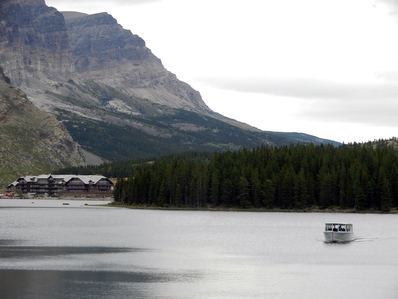 Many Glacier Hotel on Swift Current Lake
Many Glacier Hotel on Swift Current Lake The next day we took a hike around two glacial lakes in the northeast section of the park near Many Glacier Hotel. As we made our way around Lake Josephine at the southernmost edge of the trail, we found ourselves walking through endless raspberry bushes, full of the ripe berries. We had mixed feelings about all this abundance. They are delicious, so we enjoyed our share of them. However, it wasn’t lost on us that the bears in the area were probably enjoying them as well. Sure enough we saw some fresh bear scat full of berry seeds. Since we found ourselves alone on this part of the trail, we began singing every camp song we could remember, making sure any bear knew we were coming. The first rule of bear encounters is don’t surprise the bear. Apparently, our singing was annoying enough it did the trick.
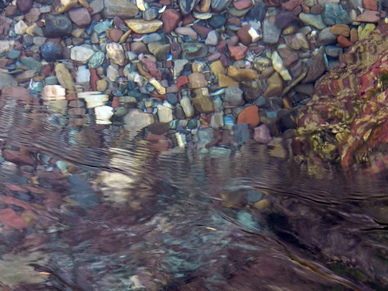 Clear water in MacDonald Creek
Clear water in MacDonald Creek In the evenings, we made our way to the nearby visitor center for some excellent programs. One was an evening of songs by a member of the Blackfoot nation. The other was about the centennial of the National Park Service, which was only a couple of days away.
Thanks to that particular anniversary, we soon discovered that we were not going to be in a National Park on the centennial.
Thanks to that particular anniversary, we soon discovered that we were not going to be in a National Park on the centennial.
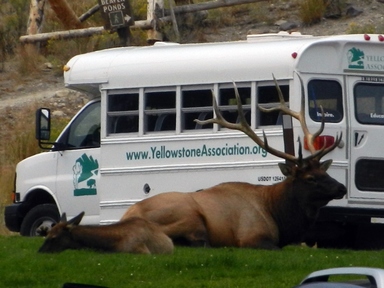 Bull elk relaxing in Fort Yellowstone
Bull elk relaxing in Fort Yellowstone Yellowstone National Park
As the nation’s first national park, Yellowstone figured prominently in the centennial of the National Park Service. There was a concert at the north entrance to the park to celebrate on the 25th that was attracting large crowds to the area. We decided to delay our arrival until the next day. After a stop in Helena at the county fairgrounds and a Bozeman Wal-mart, we arrived at the Mammoth campground at the north entrance early Friday morning and secured a couple of campsites This would be our base to explore the park for the next week.
As the nation’s first national park, Yellowstone figured prominently in the centennial of the National Park Service. There was a concert at the north entrance to the park to celebrate on the 25th that was attracting large crowds to the area. We decided to delay our arrival until the next day. After a stop in Helena at the county fairgrounds and a Bozeman Wal-mart, we arrived at the Mammoth campground at the north entrance early Friday morning and secured a couple of campsites This would be our base to explore the park for the next week.
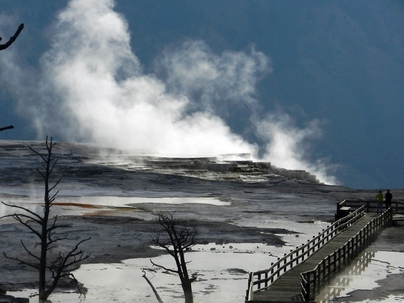 Mammoth Hot Springs
Mammoth Hot Springs As one park ranger put it, Yellowstone was created to protect the “weird” geo-thermal features within it. It sits over the site of a “super volcano” that erupted so violently a couple million years ago that instead of blowing up a mountain range, it simply dissolved it. The resulting crater or caldera still bubbles, spews and steams as the water encounters the molten rock below.
 Canary Springs
Canary Springs The hot springs in this park are not ones for swimming – their temperatures range from merely scalding to boiling hot. However they are fascinating and beautiful. At Mammoth, the springs deposit minerals that grow into terraces, adding height as fast as ¼” inch a day. They are orange, gold, green, grey and white – thanks to the heat-loving bacteria that inhabit them. They are also constantly changing. We had memories from our trip 25 years ago that didn’t match the current layout of the travertines (rock terraces). We learned that springs start and stop flowing regularly, move from one area of the hill to another. We witnessed a spring that was only 2 months old and some that had been flowing for years.
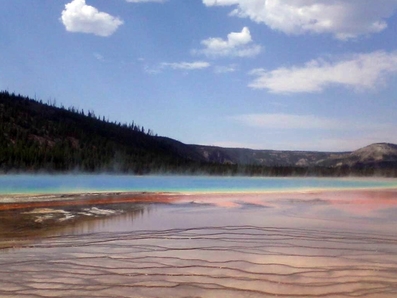 Grand Prismatic Hot Spring
Grand Prismatic Hot Spring As we traveled further south into the park, there were a variety of other thermal features. There was Roaring mountain, which is covered in fumaroles, steam escaping through numerous fissures in the rock. Grand Prismatic, the mother of all thermal pools and all of its lesser cousins, have a deep blue center that dissolves through a rainbow colored-edge into a fiery orange perimeter. There were also the Artist Paintpots, bubbling pools of mud in various hues that the native American used to paint their tipis. Mud Volcano, Dragon’s breath, the list goes on.
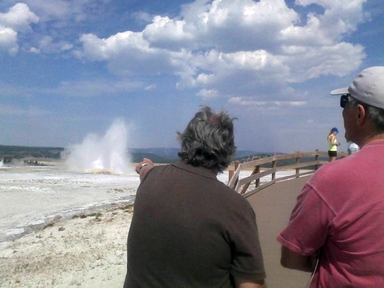 Fred and Dave watch a geyser erupt at Upper Geyser Basin
Fred and Dave watch a geyser erupt at Upper Geyser Basin But the stars of the thermal show are the geysers, which includes Old Faithful. Some erupt every few minutes, some every few hours and some, like Steamboat Geyser, haven’t erupted for years. We watched several of them erupt and they didn’t lose their fascination.
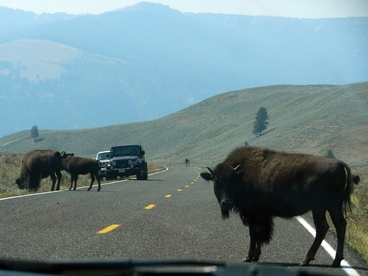 Bison Jam in Lamar Valley
Bison Jam in Lamar Valley Yellowstone was created to protect its unique geology, but the animals within its ecosystem are being protected as well. The understanding of what that means has changed dramatically since the park was created. Bison, which were on the brink of extinction a century ago now create “bison jams” when some of the population of 5000 meander across the highway. A rarer site to see, now that the park no longer allows visitors to feed them, is a grizzly or black bear. We saw some of each, but it was the stack of cars and people on the highway that were the first clue that one was nearby.
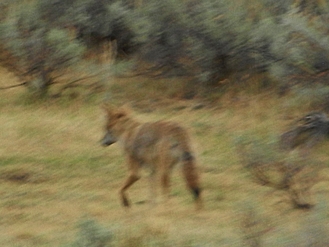
Wolves were eliminated early in the 20th century, but have been back in the park for over 20 years, now numbering about 100. They help to keep the elk, bison and bear populations much healthier. Since they actively avoid humans, we felt lucky to catch a glimpse of one in the Lamar Valley one morning. But by far the closest encounters we had were with the numerous elk that have made Mammoth Hot Springs their home. They walked through our campsite, parked themselves on the lawn and even poked their head into the door of Pat and Fred’s coach. We still had to keep our distance, since these are very much wild animals.
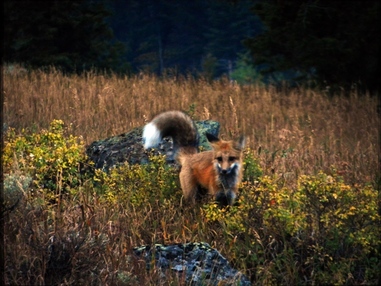
The most unique encounter we had was with a fox early one morning on a side road We watched him stalk and pounce on some small animal and then come back to show off as he sat on a rock as we drove by. We saw pronghorn sheep wondering around the stone arch near Gardiner, and a lone bison sleeping under a tree like Ferdinand the bull in the children’s story.
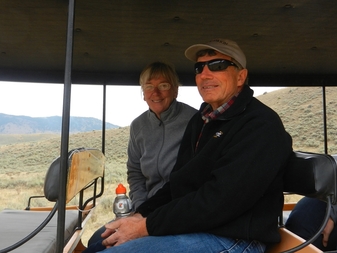 On a stagecoach ride
On a stagecoach ride One of the more unique experiences in Yellowstone is a stagecoach ride. One morning, we took one on a ride into Pleasant Valley, getting a sense of the kind of transportation that was the only option available the first 43 years of the park’s existence.
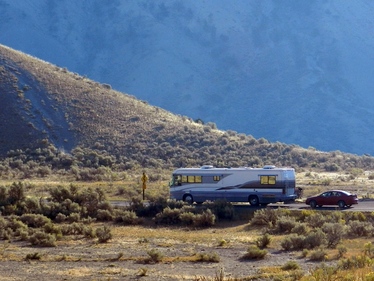 Pat and Fred headed out of Yellowstone
Pat and Fred headed out of Yellowstone As the month was coming to an end, Pat and Fred made ready to leave for some scheduled appointments to have work done on their coach. We decided to stay behind, so we said goodbyes again. We were less certain that we would see each other until we got to Florida, but it’s been a great summer adventure together.
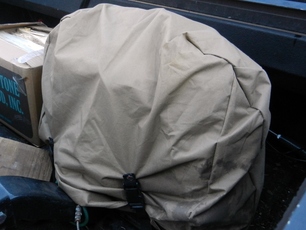 New generator under cover in truck bed
New generator under cover in truck bed RV Stuff
Although our Honda 1000 generator, which was originally purchased to charge Orion Jr’s batteries, has been doing fine charging the RV’s batteries, we were concerned that it wasn’t up to the challenge if we needed to run the A/C. While we were staying in Helena, Dave saw an ad for a sale at Harbor Freight on a generator that would do the job. We had seen one in Seward being used by someone with the same model fifth wheel. He was able to buy one and Cathy managed to modify a grill cover to keep it dry. After re-arranging the contents of the truck bed, it now has a home and it seems to be doing a good job. However, we haven’t put it to the real test yet, since it hasn’t yet gone through the break-in period. More about that in future updates.
Although our Honda 1000 generator, which was originally purchased to charge Orion Jr’s batteries, has been doing fine charging the RV’s batteries, we were concerned that it wasn’t up to the challenge if we needed to run the A/C. While we were staying in Helena, Dave saw an ad for a sale at Harbor Freight on a generator that would do the job. We had seen one in Seward being used by someone with the same model fifth wheel. He was able to buy one and Cathy managed to modify a grill cover to keep it dry. After re-arranging the contents of the truck bed, it now has a home and it seems to be doing a good job. However, we haven’t put it to the real test yet, since it hasn’t yet gone through the break-in period. More about that in future updates.
